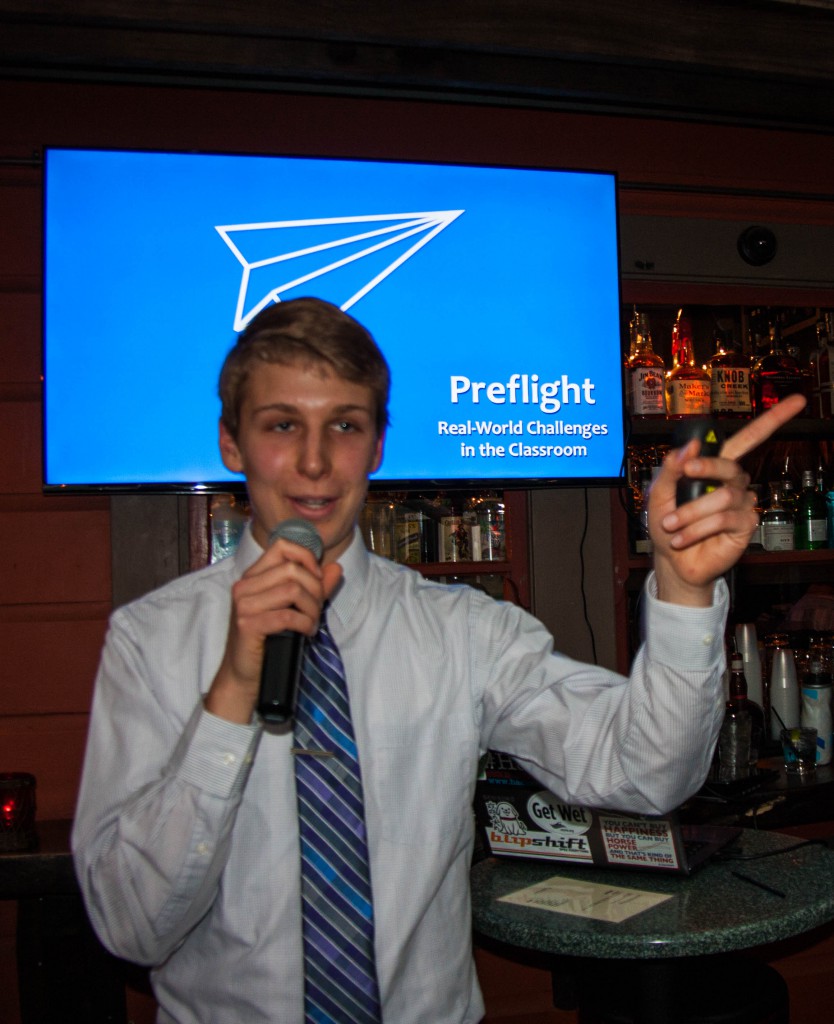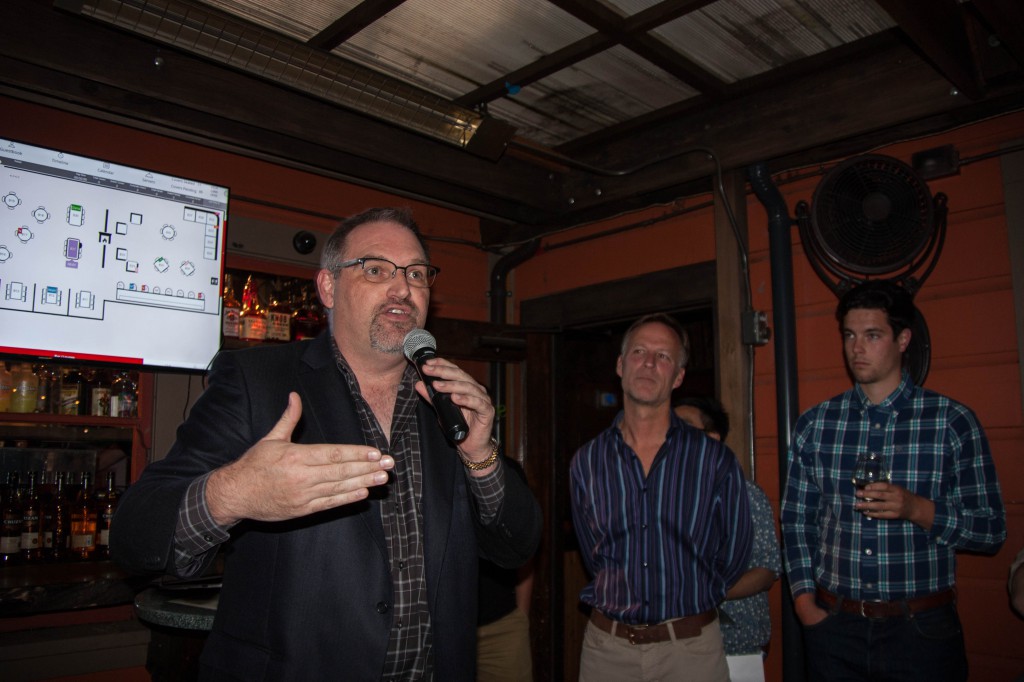
The March Jumpstart Davis event featured four new presentations, including Bret Hewitt from CxORE, Paul Katsch from Rezku, Gavin Cosgrave from PreflightChallenges.com and Terry Toy from Zebra Code.
Gavin Cosgrave is a student at Da Vinci High School who started Preflight, a program that brings professionals into high school classrooms to host challenges related to their work. “I feel like a lot of times students are unaware of the career opportunities available to them, and they don’t know exactly what skills they’ll need to succeed in their future.”
He set out to create a program that would “combine both inspiration and mentorship with real experience and skill building.” He said that, while internships can provide this opportunity, they can be hard to come by for the majority of students. He said he figured there was a better way and he “started Preflight to both help students to dream big about their futures and show them a tangible path to get there.”
First the professional and school can get together. Then the professional comes into the classroom and talks to the students about their work. He said, “Then they present the challenge which is a project that the students will be working on for the next week or two that relates to the work of the professional.”
The teacher then gives the class some guided work time, where the students work in teams. Finally, “the professional comes back into the classroom and the students present their solutions and the professional can give feedback.”
He said that this creates a loop that benefits both where the students get new skills and the professional “can actually gain new business ideas and get a chance to give back to the community.”
Mr. Cosgrave was taking an online class about different development issues last summer when he learned about an online challenge on a website called “Open Idea.” “The challenge was about designing solutions to youth unemployment” and he submitted an idea that was similar to Preflight. The idea grew from there.
He said after working on this for two months, he got an email that changed his life. The whole challenge was sponsored by the Clinton Global Initiative. “Because I was one of the winning ideas, I actually got to attend,” he said and he took days off schools and flew to New York. “It is truly inspiring to see all these leaders using their platforms to truly change the world on a massive scale.”

Paul Katsch from Rezku said he has had startups his whole life. “The last time I was employed was about 30 years ago with the Oakland Raiders, and I decided I never wanted to be employed again.”
“The business I started now is probably the most exciting and the most ambitious thing I’ve ever done,” he said. He owned a restaurant on the east coast and learned “that everyone who provides services to restaurants as far as technology were all in it for the money. They didn’t focus on the restaurant.”
He said, “You have all of these restaurants making very small margins.” The average restaurant owner “makes between 3 and 9 percent profit on everything you spend.”
“If someone walks out the backdoor with a bag of scallops, that restaurant struggles for a long time,” he said. “The hardest thing to do is to own a restaurant.”
So he decided to write his own software. He decided to go up against the big boy software companies. “I wrote my own software and it was a big flop,” he said. “It wasn’t good enough. That’s part of doing a startup is making mistakes and learning from them.”
Mr. Katsch said he went back to the drawing board. After that he bought a booth at the National Restaurant Association, “and all I did was talk to restaurant owners.” That gave him a clear idea of what they face every day. “One thing that restaurant owners hate is technology. They hate technology and they hate change,” he said.
He said he needed something that was not technology based and didn’t require training. Open Table, he said, is terrible on the restaurant side. “It was built 15 or 16 years ago.” He joked, “Bill Clinton was president, remember Monica Lewinsky? It’s that far back that it was developed. It’s all Window 98-based. It’s very poor now.”
“Technology has changed greatly in that time,” he said. Open Table is like Micosoft Excel and his interface allows him to touch the table, combine the table, create different floor plans all with the touch of a finger.
“Everything is meant for someone who’s 16 years old, who is in high school, to use,” he said. “Because when you walk into a restaurant, the host is mostly 16 years old. They’re right out of high school.”
He said, “Restaurant owners look at this and say ‘how difficult.’ Their hosts see it and say ‘my god, how cool.’ That’s how we get adoption.”
“Breaking into the restaurant industry is very hard,” he said. “Open Table paid between $4000 and $6000 for each new customer. They spent hundreds of millions of dollars to acquire new customers. We had to go out with a lot less money to compete against them.”
He has done this without venture capital. He said that when you have a venture capitalist in your group they try to control the direction you go in and he felt he knew the market himself.
“I felt that I knew the market better than they did and I probably met with 20 venture capitalists,” he said. “I decided I was going to do things differently.”
He said where they are going is to utilize big data in the restaurant business. He said, “No one has been able to grab the data from the time a reservation has been made to the time you leave a restaurant. Nobody. Not Open Table, not Yelp, not anyone.”
“It’s so exciting because we’re seeing major restaurant chains coming to us right now,” he said. “Now they’re coming to us in droves.”
He said he has had to invest $3 million of his own money into this and he needs another $1 million to make this work.
“We’ve revolutionized the industry,” he said.
The Vanguard will have the second part of this report tomorrow, with the presentations of Brett Hewitt and Terry Toy.
—David M. Greenwald reporting






very interesting, looking forward to part two.
I have had the good fortune to attend two of the JumpStart Davis events. I have found both events to be very exciting and educational. This is innovation. This is about people having new ideas or new twists on established ideas.
I would strongly urge anyone who has an interest in the creativity being demonstrated here, whether or not you are yourself interested in participating in a start up to attend one of these events. To me this is one example of the best potential interface between those with ambitious new ideas whether they be high school or university students or are themselves in business, or simply someone who cares about the well being of our community with others. And, this is occurring on a restaurant patio, no high tech, expensive, land consuming space required for a free exchange of ideas.
Thanks Tia! So glad you’re finding the events exciting and educational 🙂